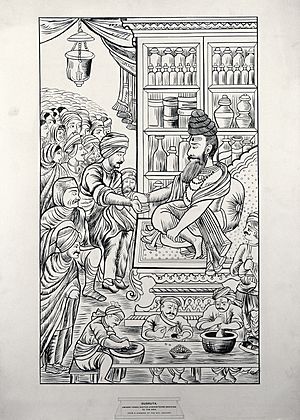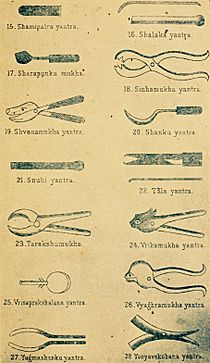Sushruta facts for kids
Quick facts for kids
Maharshi
Sushruta
|
|
|---|---|

Sketch of Sushruta
|
|
| Born | c. mid 1st millennium BCE |
| Known for | Author of Sushruta Samhita |
|
Notable work
|
|
| Scientific career | |
| Institutions | Banaras University |
Sushruta (pronounced Soo-shroo-tah) was an important doctor in ancient India. He wrote a famous book called the Sushruta Samhita. This book is one of the oldest and most important writings about medicine. It is a key text for Ayurveda, an ancient Indian system of medicine.
The Sushruta Samhita talks about all parts of medicine. But it is especially famous for its detailed chapters on surgery. Because of this, some people call Sushruta "the father of surgery." His book says he lived in Varanasi, India.
Contents
When Did Sushruta Live?
Sushruta lived a very long time ago. Some experts think his ideas might be from around 600 BCE. However, the Sushruta Samhita was written over many years. It likely started to be written in the last few centuries BCE. The book we have today was finished by another writer around 300–500 CE. It is also possible that there were several ancient doctors named "Sushruta."
Sushruta's Students
Sushruta had many students, who were called Saushrutas. These students had to study for six years. Only after this could they start learning surgery with their hands.
Before they began training, they took a serious promise. They promised to help people heal and never to harm anyone. This promise is similar to the Hippocratic Oath that doctors take today.
After Sushruta accepted his students, he taught them how to do surgery. They practiced cutting on vegetables or dead animals. This helped them learn how deep and long to make a cut. Once students were good at practicing on plants or animals, they could watch real surgeries. Then, they were allowed to do their own operations. Sushruta taught his students everything about medicine, including how the body is built (anatomy).
Sushruta's Ideas on Medicine
Sushruta wrote the Sushruta Samhita as a guide for doctors. He believed doctors should treat the whole person. He thought that sickness happened when the body was out of balance. A doctor's job was to help people stay balanced or get back in balance.
Sushruta also believed that doctors and nurses needed to be balanced themselves. He described a good nurse like this:
- They should be calm and kind.
- They should not speak badly about anyone.
- They should be strong and pay attention to what sick people need.
- They must always follow the doctor's instructions.
Sushruta's Amazing Legacy
One of Sushruta's most famous achievements was nose surgery, also known as rhinoplasty. He could rebuild noses that were damaged or lost. He used a piece of skin from the patient's forehead to fix the nose. This method is still used today and is sometimes called the "Indian flap" technique.
People in India knew about this type of plastic surgery even into the late 1700s. Reports from that time, like in the Gentleman's Magazine in London (1794), show this knowledge.
See also
 In Spanish: Súsruta para niños
In Spanish: Súsruta para niños


